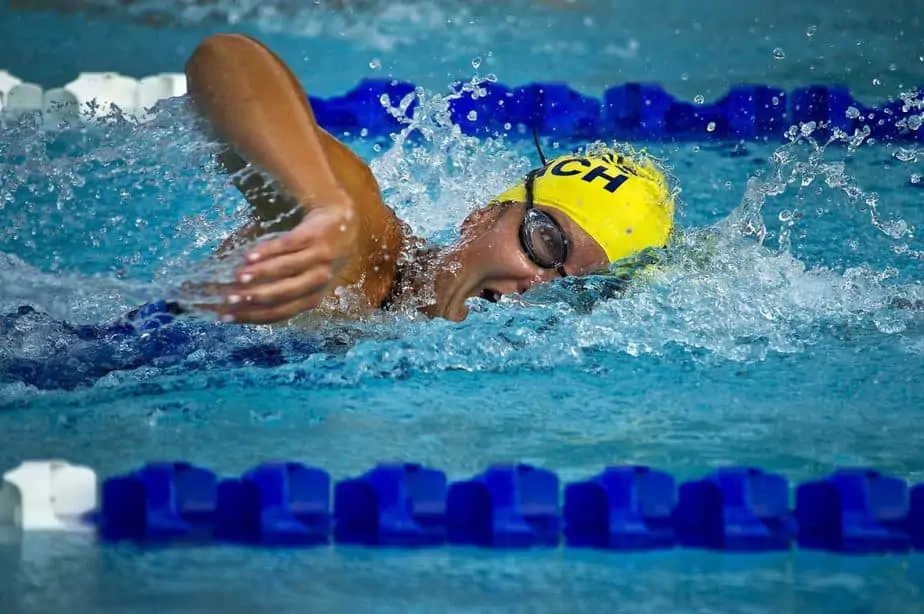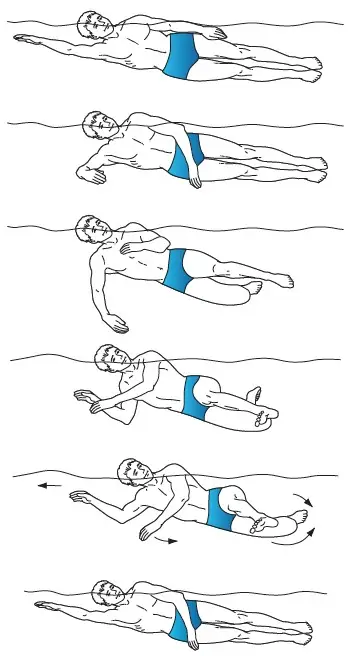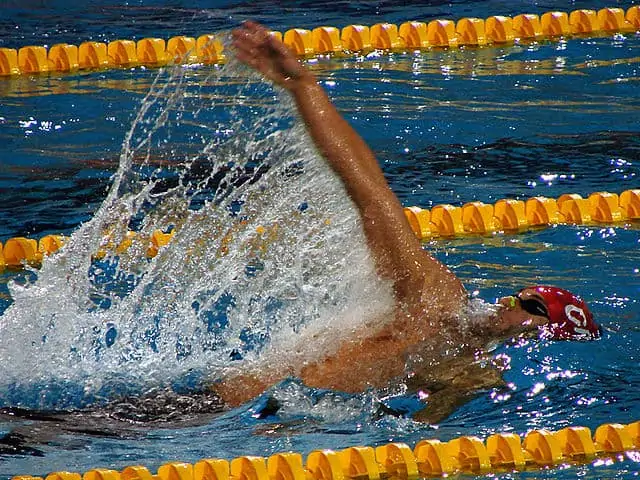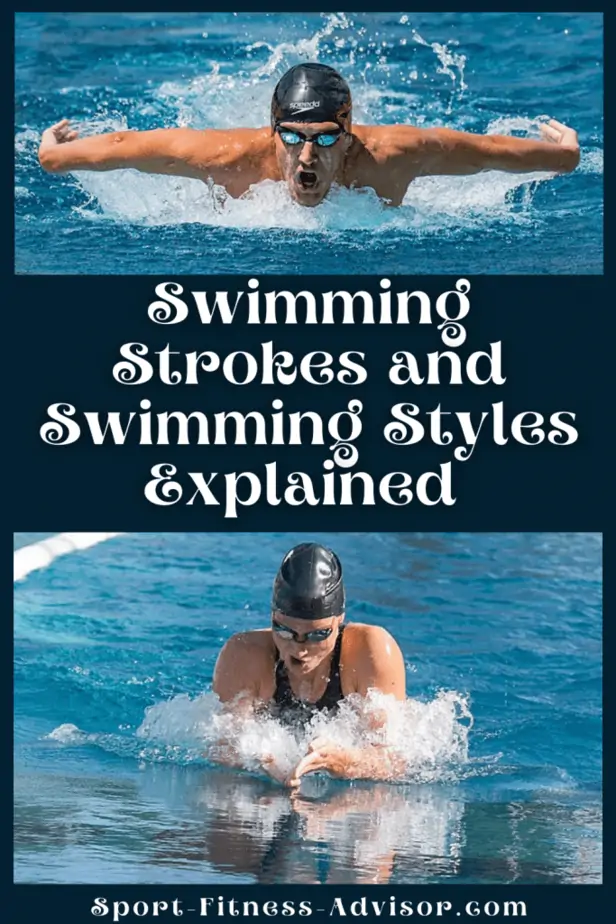Swimming is an individual or team sport that takes place in the water (a pool, lake, or the ocean). The sport requires moving the entire body through the water by using most of the muscles in the body. Swimming has four strokes which are swum competitively – butterfly, backstroke, breaststroke, and freestyle.
A fifth stroke known as sidestroke is also considered as one of the strokes of swimming, however, it is not swum at a competitive level. An individual medley is a competitive event that combines all four strokes into one race, and relays are other swimming events that have four swimmers taking part in either a freestyle or medley race.
Swimming has four strokes which are swum competitively – butterfly, backstroke, breaststroke, and freestyle.
The History of Swimming
It is believed that recreational swimming was first enjoyed in prehistoric times, with the earliest evidence being Stone Age paintings dating back around 10,000 years. The earliest written references to swimming date from 2000 BC in works, such as the Bible, Beowulf, the Iliad, the Odyssey, and the Quran. The first book about swimming was written by a Swiss-German professor of languages, Nikolaus Wynmann in 1538.
In 1828, St George’s Baths was the first indoor swimming pool in England that was opened to the public, and competitive swimming emerged in the 1830s with the National Swimming Society holding regular swimming competitions in pools around London.
Swimming grew in popularity and by 1880 there were over 300 regional clubs around the country. It was in this year that the first national governing body, the Amateur Swimming Association, was formed. A form of upright freestyle, known as front crawl, was debuted by Sir John Arthur Trudgen in 1873 at a local competition in England and would form the basis for modern-day freestyle.
Competitive swimming emerged in the 1830s.
The first person to swim the English Channel was Captain Matthew Webb who swam the 21.26-mile (34.21 km) channel in 21 hours and 45 minutes in 1875. The second crossing was swum only 36 years later by T.W. Burgess.
Swimming began to grow international popularity in the late 1800s with Germany, France, and Hungary establishing swimming federations in 1882, 1890, and 1896, respectively, and the first European amateur swimming competitions held in 1889 in Vienna. The world’s first women’s swimming championship was held in 1892 in Scotland, and men’s swimming became part of the first modern Olympic Games in Athens in 1896.
The first known stroke to be swum was sidestroke and breaststroke from which it developed in the 17th century. This was followed by backstroke, which began to develop early in the 20th century, and freestyle as we know it today, which was first introduced to the Western world by Australian Richmond Cavill in 1902. Butterfly was developed in the 1930s as a variant of breaststroke.
Butterfly was developed in the 1930s as a variant of breaststroke. 40th Swimming Zone and Masters Meeting, Enns, Austria, 2017 by Isiwal/Wikimedia Commons/CC BY-SA 4.0
The Swimming Strokes Explained
There are five strokes in recreational swimming – butterfly, backstroke, breaststroke, freestyle, and sidestroke. In competition swimming, swimmers only race four of the five strokes – butterfly, backstroke, breaststroke, and freestyle. They also combine all four strokes into an individual medley.
Let’s take a look at the five different swimming strokes, how they were developed, their techniques and styles, and how they are swum today.
Sidestroke
The sidestroke is one of the earliest strokes in swimming and is so named because the swimmer lies on his/her side and makes asymmetric movements with the arms and legs. The ancient stroke evolved from breaststroke when swimmers found it too painful to swim breaststroke with the head above the water.
Sidestroke Technique
When swimming sidestroke, the body is positioned on its side and the arms propel alternately. The arm beneath the side of the body stretches forward (known as the lead arm), while the other arm (resting arm) lies on top of the horizontally positioned body.
The Arms
The hand of the outstretched arm works like a paddle, catching the water, sweeping downwards, and pulling towards the body with a bent elbow, before returning to the outstretched position. The head rests on the outstretched arm and does not move from this position throughout the stroke, allowing for free and easy breathing.
The Legs
The leg motion is called the scissors kick and sees the legs opening slowly with the upper leg forward, the under leg backward and both knees slightly bent. The legs then come back together to propel the body forward.
Today, the sidestroke is not used during competitive events but is used for lifesaving and recreational swimming. It can also be used while taking a break on long open-water swims.
Watch this video to see how to swim the sidestroke.
The Benefits of Sidestroke
Even though sidestroke is not a competitive stroke, it can be used in lifesaving for in-water rescues or taking a break on a long open-water swim. Sidestroke can burn over 400 calories per hour as it, multiple muscle groups, using both the arm and leg muscles for propulsion and the core to maintain a smooth, horizontal position in the water.
Sidestroke can be used in lifesaving for in-water rescues or taking a break on a long open-water swim. Illustration of underarm side stroke in swimming by Claraakc / CC BY-SA 4.0
Breaststroke
Breaststroke is believed to be the oldest of the five strokes and is used frequently for both recreational and competitive swimming. Breaststroke is performed with the body lying in a horizontal position, the head alternating between facing downwards and forwards, and the arms always remaining under the water.
The stroke is sometimes referred to as the “frog stroke” or “froggy” due to the kick being similar to that of a frog, and it is the slowest of the four competitive strokes. Breaststroke is the most popular style of recreational swimming as it can be swum slowly and the head is out of the water for most of the stroke, allowing for easy breathing.
Breaststroke Technique
Breaststroke involves separate movements for the arms and the legs, and the most important aspect of swimming breaststroke is the timing of these two movements. As with the three other competitive strokes, the body is in a horizontal position in the water and the arms and legs are used to propel the body through the water in the most hydrodynamic and streamlined way.
The Arms
There are three steps to the arm movement in breaststroke: the out-sweep, the in-sweep, and the recovery. The breaststroke arm movement begins with the out-sweep where the palms of the hands turn outwards and move away from each other to slightly past shoulder width.
The out-sweep is then followed by the in-sweep, where the hands push the water back towards the body in a sweeping motion until they reach the vertical plane through the shoulders. The elbows stay in the horizontal plane during this movement.
The hands then come together at the end of the in-sweep with the palms of the hands in front of the chest and the elbows next to the body. In breaststroke, the recovery phase sees the hands moving forward to the starting position in a horizontal line with the body.
The arms movement in breaststroke begins slowly and increases in speed during the in-sweep and slows down again during the recovery phase. The maximum thrust should be produced during the in-sweep phase, while the recovery phase aims to achieve minimum drag.
Maximum thrust should be produced during the in-sweep phase. Sarah Haase in 100m breaststroke by JD Lasica from Pleasanton, CA, US / CC BY 2.0
The Legs
The breaststroke kick is known as the “frog” or the whip kick and creates sufficient power to propel the body forward through the water. The legs begin in a horizontal position behind the body. The knees then bend with the feet flexed in a “z” shape and sweep upwards, outwards, and back together again.
The kick takes place after the in-sweep movement of the arms so that they are back in the horizontal position when the arms stretch forward, creating a streamlined body position in the water. The legs must move in sync with the arms to create an undulating rhythm while swimming.
The Breathing
The breathing in breaststroke sees the head coming completely out of the water when the arms move from the out-sweep to the in-sweep motion before ducking beneath the water again at the end of the stroke. The arms and shoulders are used to lift the head out of the water to take a breath and as the arms push forward into the recovery phase, the shoulders drop, taking the head back into the water.
The Importance of Timing in Breaststroke
Breaststroke is the least efficient of the four swimming strokes due to large frontal resistance in the water created by a wide kick and arm pull, and the overall body position. The most efficient part of the stroke is the glide phase after the kick and the arm recovery when the body is in a streamlined position.
The glide is formed when the legs and feet come together after the kick and the arms are fully extended with the hands held together. The body is in a smooth, streamlined position and can glide effortlessly through the water.
If the timing in breaststroke is incorrect, the glide becomes compromised and creates a greater frontal resistance, slowing the stroke down enormously. If the kick is too late or the arm pulls too soon, the timing of the stroke is out and causes a disjointed and inefficient swimming stroke. Thus, the timing of the stroke is essential in helping to produce a smooth and easy swimming stroke.
Breaststroke drills are the key to mastering these vital elements of the stroke. They also help to clean up the breaststroke pull and hit race pace tempo in both training and racing. The correct breaststroke drills can help you over-emphasize the weakest part of your stroke so that you can improve your overall swimming.
The Benefits of Breaststroke
Breaststroke is the most popular stroke as it allows the swimmer to breathe fairly easily and because it is the slowest swimming stroke, can be swum for long periods. Breaststroke burns a minimum of 400 calories an hour if swimming at a moderate pace but can burn many more calories if swum at speed.
Breaststroke is a good overall body and cardio workout as it works multiple different muscle groups, particularly the chest muscles and hamstrings. Because all the power in breaststroke comes from the legs, the thigh muscles, quads, and core muscles benefit greatly.
Breaststroke is a good overall body and cardio workout.
Freestyle
Freestyle, also known as front crawl, is a stroke used in competitive freestyle swimming and the fastest of all four strokes. It is also the preferred choice of stroke for covering long distances and big swims like the English Channel.
Freestyle Stroke Technique
Freestyle is swum with the body in a prone position on the stomach with the face in the water. Both the arms and legs move in an alternating motion with the legs kicking in small flutter kicks.
The Arms
The arms move in an arc from the hip over the water to in front of the head. The hands and fingers are relaxed, and the hand enters the water in line with the shoulder before the arm stretches forward and extends to full length. With a slight bend in the wrist, the hand then ‘catches’ the water in an early vertical catch and pulls past the body downwards to the hips. The elbow then bends to lift the arm out of the water for the recovery phase of the stroke as the arm moves over the water once again in an arc.
The Legs
The flutter kick is used in freestyle by constantly moving the legs in a controlled, scissor-like movement with the knees slightly just beneath the water. The kick must come from the hips and not the knees and the numbers of kicks per cycle of arm movement can be adjusted to increase or decrease speed. The freestyle kick only provides 10 percent of the overall propulsion in the stroke.
The Breathing
Breathing in freestyle involves the head-turning to the side when the arm swings up and out of the water. As the arm enters the water again, the head turns back to face downwards in the water.
The best way to breathe in freestyle is bilaterally, which is after three full arm cycles. This creates a balanced stroke and teaches the swimmer to breathe on both sides. This can be helpful when swimming in rough open water and you need to breathe on the opposite side of where the waves are coming from.
The Benefits of Freestyle Stroke
Freestyle or front crawl is the most efficient stroke and is favored by both sprinters and long-distance swimmers. Swimming freestyle burns hundreds of calories in an hour, depending on the speed at which it is swum, and provides a full body and great cardio workout with all the muscles in the arms, legs, back, and core being worked.
Freestyle, also known as front crawl, is a stroke used in competitive freestyle swimming and the fastest of all four strokes.
Backstroke
Backstroke was born in the 20th century and is one of the four strokes swum in competitive events. It is a long-axis stroke similar to that of freestyle and swum in a prone position on the back with the head out of the water.
While backstroke may have the advantage of easy breathing with the head out of the water, swimmers cannot see where they are going, so it takes some skill to master the stroke for swimming at speed.
Backstroke Technique
Backstroke is swum in a horizontal position with the head facing upwards. The arms and legs move in similar ways to that of freestyle and it can be said that backstroke is a mirror image of freestyle without having to worry about any breathing technique.
Essential Elements of Backstroke
1. Body Position
The body position in the backstroke should be flat and high to allow the hips and shoulders to ride high in the water. Ideally, the ears, shoulders, and hips should form a horizontal line which is needed for minimal resistance and maximum breathing capacity.
2. Head Position
The correct head position in backstroke is essential for achieving the correct body position. The head needs to be flat and completely steady with the eyes looking directly upwards. If the head is too high, it causes the spine to bend and lowers the hips and the legs. If the head is too far back, the spine arches and pushes the head into the water, and creates resistance.
3. Arm Action
The arm action in backstroke works with the kick to propel the body through the water. The hand enters the water with a firm wrist and sweeps outwards to catch the water in a downward pattern. The hand sweeps up and down again at 90 degrees to the body in a pushing action. The hand releases the water and the recovery begins with a relaxed wrist and forearm.
4. The Kick
The backstroke kick is generated from the hips and upper legs with flexible, “floppy” ankles and the feet below the surface. A continuous six-beat kick action is recommended in backstroke to keep the hips high and maintain the correct body position. A strong core and back are important for a powerful backstroke kick.
5. Hand Entry
The hand entry is important in backstroke as the hand needs to enter the water directly in front of the shoulder with the little finger first and a fully extended arm.
6. Timing
The leading hand creates propulsion and the trailing hand releases propulsion.
7. Hip and Shoulder Rotation
This is a vital part of the stroke as it generates power and helps the body slip through the water in a smooth, streamlined position. The natural stroking sequence doesn’t generate enough propulsion for optimal performance, so an exaggerated rotation (roll of the shoulders) is needed for added power.
Specific drills to enhance these elements of backstroke need to be included in your swimming training session to improve and perfect your overall stroke and performance in the water.
The Arms
As in freestyle, the arms move alternatively, leaving the water thumb first, arcing with a straight elbow, and entering the water again behind the head with the baby finger first. With a slight bend in the wrist, the hand then ‘catches’ the water in an early vertical catch and pulls past the body downwards to the hips with the elbow bent (similar to the recovery phase in freestyle, except underwater).
The palm of the hands then turns to face downwards, pushing the water past the hips until the arm is fully extended. The arm is then lifted out of the water with a straight elbow and enters the recovery phase where the arm arcs over the water past the head once again.
The arm movement creates a slight body roll, which helps the hands to catch the water better when they enter. It is important to maintain a horizontal body position in the water to swim backstroke efficiently and minimize drag and resistance.
The Legs
The same flutter kick used in freestyle is used in backstroke with the kick coming from the hips and not the knees. It is very important to maintain a constant kick in backstroke as if the legs stop kicking, the hips drop, and the body becomes unbalanced. This creates drag and resistance and slows the forward momentum.
The Benefits of Backstroke
Backstroke burns approximately 500 calories per hour and is a relaxing stroke to swim. It offers several benefits that are distinct from the other strokes including improving posture, strengthening the core muscles, improving hip flexibility, and working the arms and leg muscles.
Backstroke is swum in a prone position on the back with the head out of the water. Gordan Kožulj swimming backstroke at 2008 Euros by Michiel Jelijs from Groningen, The Netherlands / CC BY 2.0
Butterfly
Butterfly is the most challenging of the four strokes and requires good coordination and strength that takes time to develop. The stroke was introduced by Henry Myers in a race in 1933 and was recognized as a competitive stroke in 1953. Originally, butterfly was swum with a breaststroke kick before it was abandoned for the dolphin kick, in which two kicks are used to one arm pull.
Butterfly Stroke Technique
Named for the arm movement in the stroke, which looks like the wings of a butterfly, butterfly is swum in a horizontal position with the head facing downwards. The body moves in an undulating motion with both arms being used simultaneously and the legs using a dolphin kick.
The most important aspect of the butterfly stroke is good body position and coordination and when these two elements are perfected, swimmers look as if they are moving through the water in an effortless forward motion.
Even though the body moves through the water in an undulating, wave-like motion, a stable, high-hip floating body position is vital to a good butterfly stroke. Maintaining high hips balances the stroke and combines the actions of the lower and upper body in a smooth and streamlined way.
Common mistakes made by swimmers when swimming the butterfly include trying to achieve the undulating motion of the stroke by moving the hips forward and backward. This lowers the hips, eliminates core stability, and unbalances the stroke.
The Arms
The arms begin extended out together in front of the head in a streamlined position with the body in a horizontal position and the face in the water. The arms then sweep out and downwards in the shape of a keyhole beneath the body before extending backward past the hips. The thumbs should gently swipe the hips as they extend. The elbows then bend to lift the arms out of the water where they then sweep over the water as low and as straight as possible before entering in front of the head to come together again.
The Legs
The butterfly kick is known as the dolphin kick in which both legs are together and move up and down like the tail of a dolphin. For every arm cycle, there are two kicks – the first is performed when the arms are pulling through the water beneath the body and the second when the arms are arcing over the water.
The heels and soles of the feet should break the surface of the water on the upward kick, while the downward kick should be hard enough to propel the body forward. The dolphin kick in butterfly causes the body to move in an undulating motion, which helps to propel the body forward in a smooth movement through the water.
The Breathing
The breathing technique for butterfly is similar to that of breaststroke in that the head lifts out of the water during an arm cycle. As the arms move into the recovery phase of sweeping over the water, the head lifts for a breath and re-enters the water when the arms enter the water.
The Benefits of Butterfly
Butterfly burns the most calories of any swimming stroke, approximately 900 calories for every hour swum. Swimming butterfly provides an excellent all-body workout with a focus on the core and upper body. It also works the arms, chest, and upper back muscles, and improves coordination and flexibility.
Butterfly burns the most calories of any swimming stroke. Ryan Lochte winning in 100m butterfly at the 2013 Santa Clara Grand Prixby by JD Lasica / CC BY 2.0
The Individual Medley
The individual medley is a combination of all four strokes – butterfly, backstroke, breaststroke, and freestyle into one event and is swum at a competitive level. The individual medley can either be swum as a single race or as a relay known as a medley relay where each stroke is swum by a different swimmer.
The order of the individual medley is butterfly, backstroke, breaststroke, freestyle, while the order for the medley relay is backstroke, breaststroke, butterfly, freestyle so the first swimmer can start in the water.
Individual Medley Technique
The technique for individual medley events does not differ very much from the technique for each of the four strokes. The main difference is the turns at each transition from one stroke to the next whereby each turn needs to be completed according to the rules of each stroke.
Rules of the Four Swimming Strokes
- Butterfly and breaststroke swimmers have to touch the wall with two hands next to each on both turns and finishes.
- Backstroke swimmers must finish the race by touching the wall on their back.
- During the backstroke turn, swimmers may turn onto the stomach, take one freestyle arm pull and move into a tumble turn, before pushing off on the back once again.
- For a backstroke to breaststroke turn, swimmers can do an open turn or a backflip turn, where the swimmer touches on the with one hand, tucks the knees up to the stomach, and flips around so that the feet are touching the wall and pointing downwards. They then push off of the wall on their stomach.
- Freestyle flip turns or tumble turns do not require swimmers to touch the wall before moving into the flip turn.
Final Thoughts
All the strokes in swimming are connected in one way or another and practicing one will benefit the others. The core is an integral part of swimming and is used in all four strokes, so having a strong core is essential to being able to swim well in all four strokes.
Happy Swimming!

Mia Russell is currently the head swim coach at Aquasharks Swimming Academy in South Africa. She has worked as the head swim guide at SwimQuest Open Water Swimming Holidays in London and was previously a Swim Coach at Cybersmart Aquatics. She has a AIDA International Level 3 Freediving Certification, PADI Open Water Advanced Certificate, SSI Level 1 Free Diver Certificate and RYA Beach Lifeguard Certificate.










